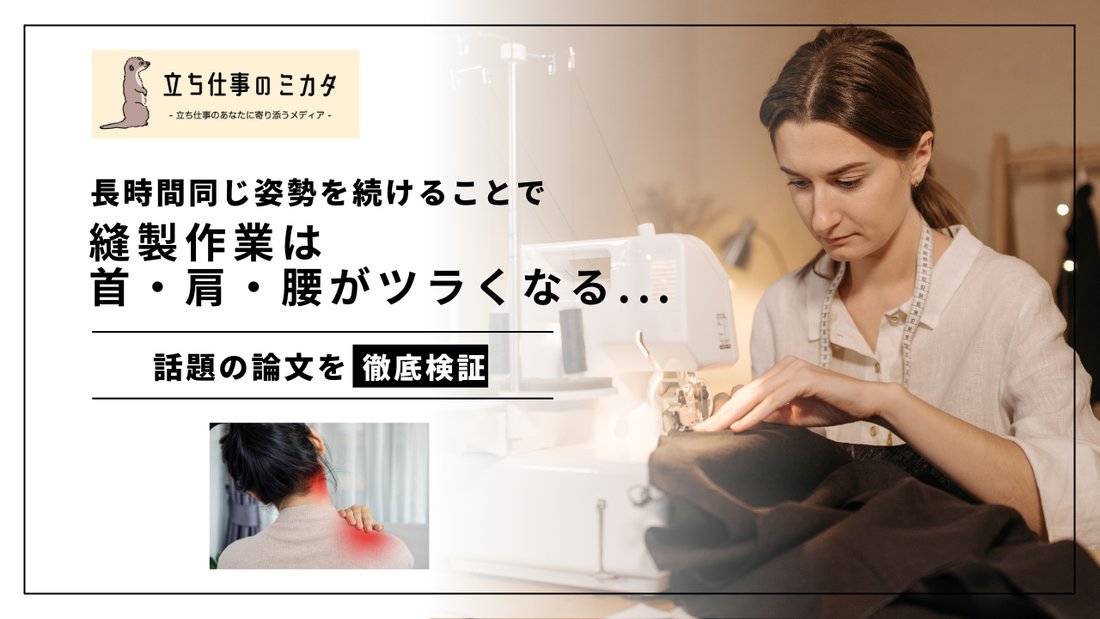
Sewing can be hard on the neck, shoulders, and back due to maintaining the same posture for long periods of time.
Share
Introduction: Occupational diseases and their impacts among tailors
Tailors are often prone to musculoskeletal disorders (MSDs) because they must maintain the same posture for long periods of time while performing manual tasks. In particular, a study conducted by Dr. Ganesh Rahane et al. on tailors in the Aurangabad region of Maharashtra, India, found that many of them suffered from pain and discomfort in areas such as the neck, shoulders, lower back, and wrists.
Tailors often work long periods in a seated or floor-sitting position, adopting unergonomic postures such as tilting their heads forward, elbows above or below their shoulders, and wrists bent inward, which can lead to chronic pain and discomfort that can ultimately lead to reduced work efficiency and reduced physical function.
Purpose of this study
This study aims to analyze the working environment of tailors and reduce the risk of MSDs by improving the working environment and optimizing working posture . The specific objectives are as follows:
- Assessing the socio-economic status of tailors
- Analyze the work environment and organizational structure of the workplace
- Measuring physical discomfort and ergonomic risks experienced by tailors
- Conduct a survey on awareness of workload and job requirements
- Propose ways to improve working posture
Research methodology and analytical techniques
The study involved a work environment and posture analysis of 119 tailors (58 males and 61 females). The survey used the OWAC Work Posture Analysis System (OWAS) and the Cornell Musculoskeletal Discomfort Questionnaire (CMDQ) to assess their posture and discomfort levels during work.
Main evaluation indicators
-
OWAS (Ovako Working Posture Analysis System)
- Back, arm and leg movements are assessed using a four-level code
- 63% of tailors reported feeling strain on their backs
- 50% had problems with their arms and 40% had problems with their legs.
-
CMDQ (Cornell Musculoskeletal Discomfort Questionnaire)
- The areas where tailors felt the most discomfort were the neck (7.81 ± 3.7), shoulders (9.3 ± 6.2), upper back (7.73 ± 4.2), and lower back (7.57 ± 4.3).
- 91% of tailors reported neck pain , and 67% reported that it interfered with their daily life.

Ergonomics Analysis of Work-Related
Musculoskeletal Disorders in Tailors of
Aurangabad District, Maharashtra

Ergonomics Analysis of Work-Related
Musculoskeletal Disorders in Tailors of
Aurangabad District, Maharashtra

Ergonomics Analysis of Work-Related
Musculoskeletal Disorders in Tailors of
Aurangabad District, Maharashtra
Results and Discussion
The study confirmed that tailors are at high risk of musculoskeletal disorders, especially in areas such as the neck, shoulders, lower back and wrists, due to the high strain they are subject to.
Main causes
-
Long-term posture
- Sitting for long periods while sewing can cause muscle fatigue.
-
Improper working posture
- Slouching and improper arm positioning can increase muscle strain.
-
Non-ergonomic aspects of the work environment
- Unadjustable chairs and tables, poor lighting, etc.
-
Lack of rest time
- Not taking enough rest can lead to increased fatigue
Ergonomic interventions to improve
The study recommends the following ergonomic interventions to improve tailors' working environments:
1. Improving the working environment
- Introducing adjustable chairs (with adjustable back and seat height)
- Adjustable work surface height (allowing you to maintain proper arm position)
- Organizing your workspace (ensuring a comfortable working space)
- Optimized lighting (prevent eye strain)
2. Guidance on working posture
- Stretch regularly (especially your neck, shoulders, back, and wrists)
- Make it a habit to sit and maintain good posture (straighten your back and keep your elbows at about 90 degrees)
- Take short breaks (taking short breaks between tasks will reduce fatigue)
3. Changing mindset in the workplace
- Ergonomics training for tailors
- Raising awareness among managers about the importance of improving the work environment
Conclusion
This study clarified that in order to reduce the risk of musculoskeletal disorders faced by tailors, it is essential to improve the working environment based on ergonomics and review posture. In particular, simple measures such as appropriate adjustment of chairs and work tables , introduction of stretching habits , and ensuring short breaks can significantly reduce the risk of MSDs.
In the future, workplace-wide changes in awareness and investment in facilities will be required to enable tailors and other people who work in standing jobs to maintain a healthier working environment .

